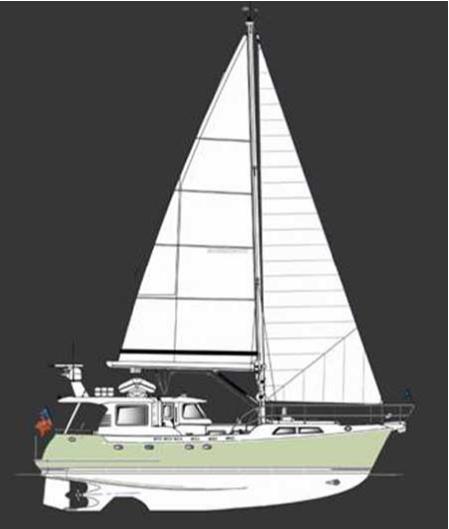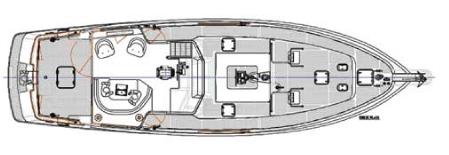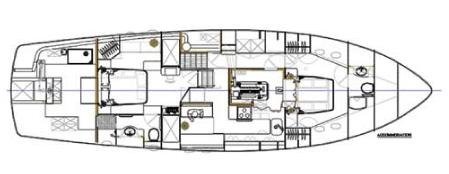 |
||
|
||
Stay informed with Trawler News from Trawlers & Trawlering! |
||
Name: |
E-mail: |
|||||||
© 1997-2014 Water World Productions, formerly Trawler World Productions. All rights reserved. Reproduction of material from any trawlersandtrawlering.com page without written permission is strictly prohibited. Any copyrighted images remain the property of the copyright owner and are believed to be used with permission. Unsolicited letters, e-mails, articles and other materials submitted to us may be published, distributed and stored by Water World Productions and its assignees in whole or in part, in print or by any other means, including but not limited to electronic, and may be edited for clarity and space. Trawlers & Trawlering and its abbreviation T&T, I'd Rather Be Trawlering, Passagemaking Under Power and its abbreviation PUP, Trawler Buy-Sell-Trade, Trawler News, Circumnavigator, and Power Catamaran World are trademarks of Water World Productions.
|
||
Best of both worlds
The Nordhavn 56 Motorsailer offers the joys of cruising—without the work of sailing—in a passagemaker Robert Beebe would love
Hull #1 of the Nordhavn 56 Motorsailer will be ready to launch in mid-2007 from Ta Shing Yacht Building Company, a partner factory of Pacific Asian Enterprises for almost three decades.
When Captain Robert Beebe first wrote Voyaging Under Power in 1975, long-range cruising, or passagemaking, as Beebe called it, was limited to people who possessed the necessary sailing skills. To broaden the appeal, Beebe created the passagemaker, a trawler yacht whose design and capabilities put voyaging the world within reach of a wider audience. Early passagemakers incorporated a small sailing rig intended to add speed and range under favorable wind conditions, as well as help stabilize the boat against roll.
If Beebe were alive today, he would instantly recognize the new Nordhavn 56 Motorsailer, with its sloop-rigged jib and mainsail, as perhaps the ideal iteration of his original passagemaker design. Clearly, the Nordhavn offers the best of both worlds in an elegant, rugged package.
The idea for the Nordhavn motorsailer first came to Jim Leishman, vice-president of Pacific Asian Enterprises, and his brother Jeff, PAE's chief designer, during their 2001-02 circumnavigation aboard a Nordhavn 40.
"When we went around the world in that 40," says Jeff, "we'd often find ideal conditions for a boat like this-down swell, downwind with the trade winds blowing a minimum of 15 knots, maximum 20 knots. It would have been so perfect for a set of sails."
Jim Leishman acknowledges that the idea for the motorsailer goes back to PAE's roots. After all, PAE built more than 300 Mason sailboats still highly regarded for their bluewater capabilities. Motorsailers, however, are different from sailboats. "Motorsailers have always appealed to a different kind of person-someone who's comfortable with a leg in each camp," says Jim. "There's a romance to sailing and it's for good reason."
Attitudes toward motorsailers tend to vary with experience, but the prevailing opinion is that a boat that is 50 percent powerboat, and 50 percent sailboat is only half as good for each task. Consequently, existing motorsailers tend to fall into one camp or the other, with the sailboat types such as the Fisher and Westsail more common. These are essentially sailboats with a pilothouse, and slightly larger fuel and water tanks to facilitate their longer range.
The Nordhavn Motorsailer, on the other hand, is optimized for powered passagemaking and has most of the advantages of a long-range trawler yacht, including a hefty displacement to length ratio (basically a measure of how much stuff a boat can hold), large fuel and water tanks, a pilothouse, deck-level main saloon, high bow for powering into head seas and a highly efficient industrial-grade diesel engine.
Jim Leishman feels it has all the advantages sailors want in a sailboat. "It's a fast passagemaker and I think it's a beautiful boat in profile. Real salty. I find myself thinking about a boat like this."
In the 56, designer Jeff Leishman has taken advantage of some sailboat/powerboat synergies in performance, range, stability and safety.
Both trawlers and sailboats are full-displacement vessels, so their hull shapes are optimized to operate at or near their hull speed (optimum speed for a given length). Whether they are powered by an engine or driven by sails makes very little difference; however, there are slight variations in each design on which Jeff has capitalized. For example, the 56's hull isn't as streamlined as a sailboat's, but compared with its trawler cousins it's a fast hull with a finer entry and a prismatic coefficient (a measure of streamlining) optimized for passagemaking speed/length ratios. Its sail assist gives it an additional turn of speed, whereas a trawler yacht on a long-distance passage may need to throttle back to a lower (and less efficient) S/L ratio in order to increase range.
"With the sail assist and everything going the way you wanted it to go-the engine throttled back and a speed of seven to eight knots-I would say it would easily have a 7,000-mile range," says Jim.
The Nordhavn motorsailer's hull also takes advantage of the beaminess common to trawlers, giving it both more usable space and the stiffness, or lower angle of heel, desirable in a sailing vessel. Jeff also notes that it has a wider stern than a pure sailing vessel, which should help resist the tendency for the aft to squat at higher speeds.
One of the features of full-displacement trawler yachts that makes them such capable open-ocean boats is their great range of positive stability. With 15,000 pounds of ballast (25 percent of its total displacement) and its tankage mounted low along the keel, the 56 should be a stable, secure boat in just about any sea condition.
Though not a shoal-draft keel, the hull's full keel helps keep draft down to six feet and is also less vulnerable in a grounding than a fin keel. In addition, the 56's skeg-hung rudder and protected prop are also less prone to damage-a desirable feature for both bluewater sailboats and trawlers.
Ocean-going trawlers need some type of roll damping, generally either towed paravanes or actively controlled fins. The advantage of the motorsailer is that the sails, spars and rigging would automatically provide this capability, thereby decreasing complexity and increasing reliability. Using sails for stability even contributes to increasing the motorsailer's range because the drag created by fins or paravanes can cost a boat anywhere from a half-knot to a knot in speed. In order to go six knots, you need to burn seven knots worth of fuel, which limits range.
On a motorsailer, on the other hand, with both sails and engine providing propulsion, and the sails providing stabilization, that same seven knots of fuel could get you eight or even nine knots of speed. "It's amazing what a little bit of power does to the performance of a sailboat," says Jim Leishman. "You've got sails up and they're drawing and you have a little bit of power pushing the boat; it'll really go."
If the owner did opt to put paravanes or fins on the boat he could use them when running under power alone; however, using fins when sailing could provide another one of those unique synergies by helping to control that corkscrewing motion sailboats sometimes exhibit when they're running dead downwind (a common type of passage, especially in the trade winds). They could also be used to counteract the heeling force created by the wind on the sails, thereby letting the boat sail more upright and comfortably.
The living and working areas and the overall layout of the 56 also benefit from the trawler/sailboat synergy. For example, its deck-mounted pilothouse presents less windage than the traditional high-mounted pilothouses found on most trawler yachts. At the same time, placing the main saloon at deck level is a common powerboat practice that offers the advantages of a roomy, enclosed living area with plenty of light, ventilation and a view-something not typically found in the narrow, down-in-the-hull main saloon of a sailboat.
The sailing rig, of course, is an integral feature of the motorsailer. Designed primarily for off-the-wind and downwind sailing, it would no doubt provide a net gain in speed on many points of sail over what would be possible with engine alone. Aside from the benefits of simplicity of operation, silence, and free added speed and range, the motorsailer skipper also enjoys the peace of mind of knowing he can always get where he's going without the complexity of a redundant get-home wing engine.
Jeff Leishman designed the rig itself to be easily handled. The foresail and mainsail together total about 800 square feet and both would be furling units. The sail trimming winches would be hydraulically operated, thereby relieving the crew of the onerous task of winch grinding and also introducing the possibility of remote sail trimming from the comfort and security of the pilothouse.
The Nordhavn motorsailer boasts an engine room that most trawler owners would love to have, let alone what you'd expect to find on a sailboat. Free of the need for a space-robbing wing engine, it measures seven by eight feet, has a generous six feet of headroom and features two items that would be considered a luxury in any other boat this size-a workbench (complete with stainless steel top and vise) and an overhead hatch for ventilation and light. A 110-volt engine-room blower augments ventilation. There's even room for a washer and dryer and a stainless steel railing around the engine. The walls are lined with perforated aluminum sheets and insulated with a combination fireproof foil and two-inch-thick leaded foam that has proven effective at keeping engine noise out of the rest of the boat.
A proven 173-horsepower L1066T.2 Lugger marine diesel engine and Twin Disc transmission connected to the Hundested propeller will provide motive power. The three main fuel tanks feed into a 40-gallon centerline aluminum day tank for a total of 750 gallons of fuel, which should give the 56 a range of about 3,500 miles. The fresh water tanks will hold 250 gallons and include sight tubes.
Displacing over 70,000 pounds, the Nordhavn 56 will be a departure from typical coastal motorsailers. With her sails furled she'll actually motor faster and farther than existing Nordhavns.
"She'll be more slippery and sleeker than what we're used to, and with the sailboat underbody she should effortlessly and quietly motor along at nine to ten knots" says PAE's chief of design Jeff Leishman. Her efficient design will be even more noticeable on long ocean passages at slower speeds. With the engine throttled back, the propeller pitched high, and under full sail she'll provide a quiet, comfortable, stabilized ride with constant electricity available and with phenomenal range-enough to take on the longest and toughest of ocean passages.
Construction of the motorsailer has started at PAE's long-time partner factory, Ta Shing Yacht Building Company.
The Taiwan-based yard currently builds five different Nordhavn models, but it originally gained fame crafting superior sailing vessels including the PAE- designed Mason sailboats as well as the Tashiba, Norseman, Orion, Sky and Taswell line of cruising sailboats . "With Ta Shing's heritage of building superior quality power and sailboats, we have all the ingredients necessary to create this truly unique and incredible yacht," says PAE's Jim Leishman.
Tooling started in November and the first hull is expected to be complete within 15 months. It will be priced at around $1.3 million which will include hydraulic power furling and winches, Lugger engine, controllable pitch propeller, generator, air conditioning, winch-anchor and chain, bow thruster, along with the finest hardware, doors and windows, steering gear and general equipment available. Additional features will include the superb electrical, mechanical and plumbing systems that are a result of PAE'S extensive offshore experience and will exude the fit and finish that Nordhavns and Ta Shing are so well known for.
The history between PAE and Ta Shing dates back almost 30 years with the introduction of the Mason 43 in 1977. Between them almost 1,000 cruising sailboats were delivered, but in recent years focus has shifted at the Ta Shing factories with production of the Nordhavn 35-, 62-, 64-, 68-, 72- and 76-foot trawler aychtrs. The new Motorsailer is particularly exciting for PAE and Ta Shing as it brings both companies back to their roots.
SPECIFICATIONS
- LOA: 57' D/L (full load): 216
- LWL: 52' 6" WATER: 250 gal
- BEAM:16'7" FUEL: 750 gal
- DRAFT: 6' HOLDING: 75 gal
- DISPL. (full load): 70,410 lb
- For a variety of excellent renderings of the Nordhavn Motorsailer and up-to-date construction photos, go <http://www.nordhavn.com/news/pressrelease/motorsailor.php4>.

- For the pilothouse and interior of the Nordhavn 46 Motorsailer, PAE has used the best of concepts from ocean-going sailing and trawler yachts.

- Editor's note: The report on the Nordhavn Motorsailer is largely based on a feature written by Jim Kirby for Circumnavigator 2006-07, the magazine for and about passagemaking sponsored by Pacific Asian Enterprises.

Great article, awesome motorsailer design . . . except for the location of the galley.
- Considering boat owner's usually eat at least three times a day, and also entertain on occasion, why would the folks at Nordhavn locate the galley so far from the salon and helm? Maybe their target market are owners with intentions of running with a full crew. Certainly not a short-handed-friendly design.
- LWL: 52' 6" WATER: 250 gal
![]()
If you wish to comment on the content of this page, please e-mail Trawlers & Trawlering